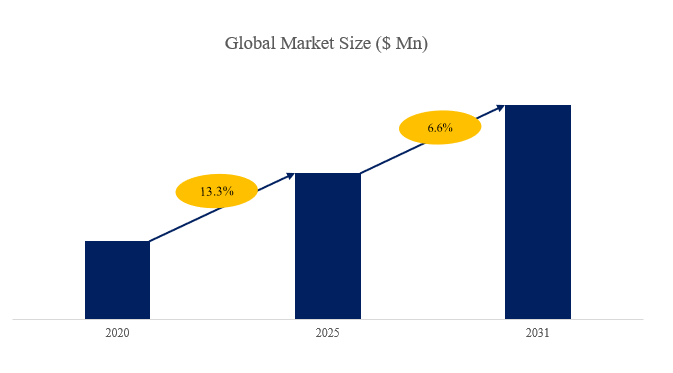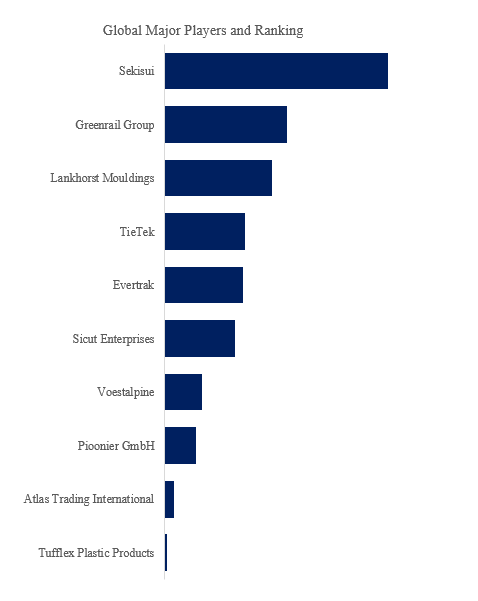Right Now
Composite Railroad Tie Research Report: the market size is projected to reach USD 1.01 billion by 2031
A railroad tie is rectangular block of support used in the railways for rail tracks. Railroad ties are beneficial in transferring the load to the rail track ballast while holding the tracks intact. Composite railroad tie is produced from recycled materials such as plastic and rubber, which makes it environment-friendly. Composite railroad tie has proven to outperform traditional tie materials due to its properties such as resistant to several weather conditions and anti-corrosive. A composite railroad tie does not crumble or decompose over time. Composite railroad tie is also moisture-resistant and immune towards infestation by insects.
According to the new market research report “Composite Railroad Tie- Global Market Share and Ranking, Overall Sales and Demand Forecast 2024-2030”, published by QYResearch, the global Composite Railroad Tie market size is projected to reach USD 1.01 billion by 2031, at a CAGR of 6.6% during the forecast period.
Figure00001. Global Composite Railroad Tie Market Size (US$ Million), 2020-2031

Source: QYResearch, "Composite Railroad Tie- Global Market Share and Ranking, Overall Sales and Demand Forecast 2024-2030”
Figure00002. Global Composite Railroad Tie Top 10 Players Ranking and Market Share (Ranking is based on the revenue of 2024, continually updated)

Source: QYResearch, "Composite Railroad Tie- Global Market Share and Ranking, Overall Sales and Demand Forecast 2024-2030”
According to QYResearch Top Players Research Center, the global key manufacturers of Composite Railroad Tie include Sekisui, Greenrail Group, Lankhorst Mouldings, TieTek, Evertrak, Sicut Enterprises, Voestalpine, Pioonier GmbH, Atlas Trading International, Tufflex Plastic Products, etc. In 2024, the global top five players had a share approximately 53.0% in terms of revenue.
In terms of product type, currently HDPE is the largest segment, hold a share of 35.3%.
In terms of product application, currently Railway is the largest segment, hold a share of 75.1%.
Market Drivers:
D1: In an EPA memorandum dated as far back as 2001, the commitment to replacing old railway ties with recycled plastic railroad ties was offered to help reduce greenhouse gases. In that memorandum, it was noted approximately ten to fifteen million wooden railway ties were replaced in the United States each year. Because wooden railroad ties are treated with creosote, the EPA felt the chemical hazards from these ties could be far worse than that of plastic railway ties. Not only will this help remove plastics from our landfills, it will reduce the amount of chemicals released into the air in and around railroad tracks. Even railway workers could be spared from diseases caused by harmful chemicals in the replacement process.
D2: A key advantage of composite railroad ties is their 50-year lifespan, compared to an average of 14 years for timber sleepers.
D3: Ban on the use of creosote treatments in various countries.
Restraint:
C1: High risks involved the global installation rate is low and has not been widely recognized.
C2: There is no standard or code that currently exists for the use of these products. In the absence of transparent standards, it is difficult under the regulatory framework to introduce new products into the railway environment due to potential safety and risk concerns.
C3: Composite ties are generally more expensive to produce and purchase than traditional wood ties.
Trend:
Rail operators are seeking for environmentally friendly substitutes more and more as worries about the effects of conventional wood ties on the environment rise. Recycled materials are used to create hybrid plastic ties, which provide a more sustainable solution. Governments all across the globe are putting rules into place to minimise the use of wood in railroad lines and promote the use of environmentally friendly substitutes. Hybrid plastic ties are in demand as a result of this. Traditional plastic ties have been replaced by new materials that are tougher and more resilient, such fiber-reinforced polymers. These components enable plastic ties to more effectively endure the tremendous weights that trains exert on them, giving them an advantage over wood ties. The rail sector is growing quickly in emerging nations, notably in Asia and Africa. As a result, hybrid plastic ties are in high demand as these nations attempt to develop new train infrastructure.
Composite railroad ties are gradually being favored by governments around the world due to their environmental protection and durability.
Composite railroad ties has begun to take shape in North America and Europe, but there is still a huge market space that has not been tapped.
About The Authors
Yin Hang
Lead Author
Email: yinhang@qyresearch.com
Tel: +86-15321687458
About QYResearch
QYResearch founded in California, USA in 2007.It is a leading global market research and consulting company. With over 17 years’ experience and professional research team in various cities over the world QY Research focuses on management consulting, database and seminar services, IPO consulting, industry chain research and customized research to help our clients in providing non-linear revenue model and make them successful. We are globally recognized for our expansive portfolio of services, good corporate citizenship, and our strong commitment to sustainability. Up to now, we have cooperated with more than 60,000 clients across five continents. Let’s work closely with you and build a bold and better future.
QYResearch is a world-renowned large-scale consulting company. The industry covers various high-tech industry chain market segments, spanning the semiconductor industry chain (semiconductor equipment and parts, semiconductor materials, ICs, Foundry, packaging and testing, discrete devices, sensors, optoelectronic devices), photovoltaic industry chain (equipment, cells, modules, auxiliary material brackets, inverters, power station terminals), new energy automobile industry chain (batteries and materials, auto parts, batteries, motors, electronic control, automotive semiconductors, etc.), communication industry chain (communication system equipment, terminal equipment, electronic components, RF front-end, optical modules, 4G/5G/6G, broadband, IoT, digital economy, AI), advanced materials industry Chain (metal materials, polymer materials, ceramic materials, nano materials, etc.), machinery manufacturing industry chain (CNC machine tools, construction machinery, electrical machinery, 3C automation, industrial robots, lasers, industrial control, drones), food, beverages and pharmaceuticals, medical equipment, agriculture, etc.
Contact Us:
If you have any queries regarding this report or if you would like further information, please contact us:
QY Research Inc.
Add: 17890 Castleton Street Suite 369 City of Industry CA 91748 United States
E-mail: global@qyresearch.com
Tel: 001-626-842-1666(US) 0086-133 1872 9947(CN)
More Posts



















Report This Post
Please complete the following requested information to flag this post and report abuse, or offensive content. Your report will be reviewed within 24 hours. We will take appropriate action as described in Findit terms of use.


